Physical Address
304 North Cardinal St.
Dorchester Center, MA 02124
Physical Address
304 North Cardinal St.
Dorchester Center, MA 02124

Hiking with kids can be magical or miserable - discover the 23 game-changing tips that make the difference between adventure and disaster.
Are you ready to transform your family’s next outdoor adventure from a potential disaster into an unforgettable bonding experience? Hiking with children doesn’t have to mean dealing with meltdowns on mountain trails or carrying exhausted kids back to the parking lot. With the right preparation and mindset, you’ll discover that children can be your most enthusiastic hiking companions. The secret lies in knowing exactly which strategies will keep them engaged, safe, and enthusiastic for the next adventure.
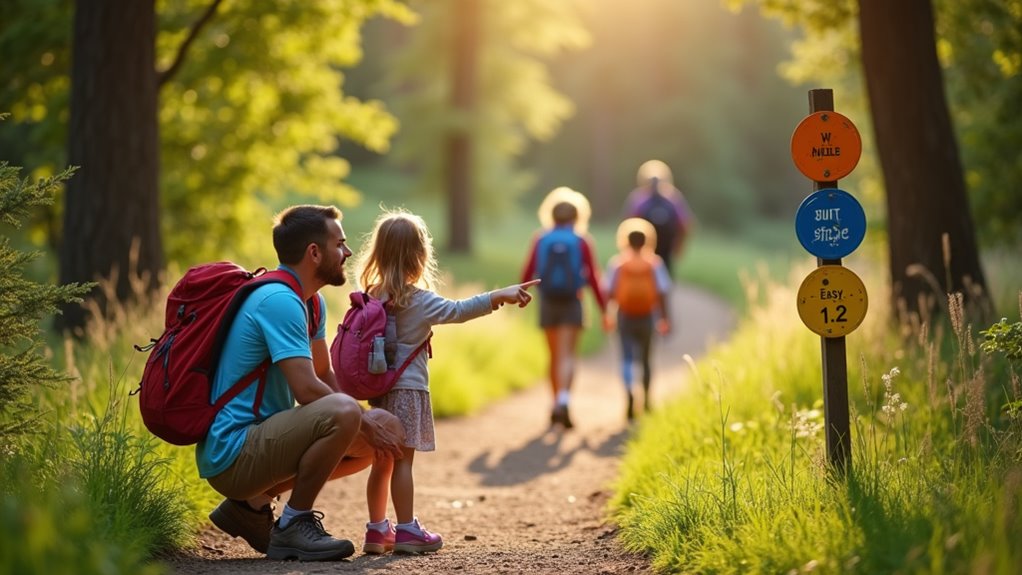
When planning your family hiking adventure, selecting the right trail makes the difference between creating lasting memories and dealing with meltdowns on the mountainside. Consider your youngest hiker’s abilities when choosing distance and difficulty. Toddlers typically handle 1-2 miles maximum, while elementary-aged children can manage 3-4 miles on moderate terrain.
Steep inclines, rocky scrambles, and narrow cliff-side paths aren’t suitable for little legs and developing coordination.
Research trail conditions beforehand using apps like AllTrails or local park websites. Look for well-maintained paths with interesting features like streams, bridges, or wildlife viewing opportunities to keep kids engaged.
Choose loops over out-and-back routes when possible—children feel more accomplished completing a circuit. Start with shorter distances and gradually increase as their stamina builds.
For overnight adventures in dense forest environments, consider bringing a jungle hammock as an alternative to ground tents, especially when camping with kids who might find elevated sleeping more exciting and comfortable.
Beyond selecting the perfect trail, you’ll need current information about conditions and weather to keep your family safe and comfortable. Check official park websites, trail apps, and recent hiker reviews for updates on closures, mud, snow, or damaged bridges. Contact ranger stations directly for the most reliable intel.
Study the weather forecast three days ahead, focusing on temperature swings, precipitation, and wind speeds. Mountain weather changes rapidly, so prepare for conditions worse than predicted.
Download offline maps since cell service often fails on trails.
Research water sources along your route—some may be seasonal or contaminated. Know where restrooms are located, as children need frequent stops. If temperatures are expected to drop significantly, pack essential gear to ensure your family stays warm throughout the hiking adventure. This preparation prevents unpleasant surprises and helps you pack appropriately for whatever nature throws your way.
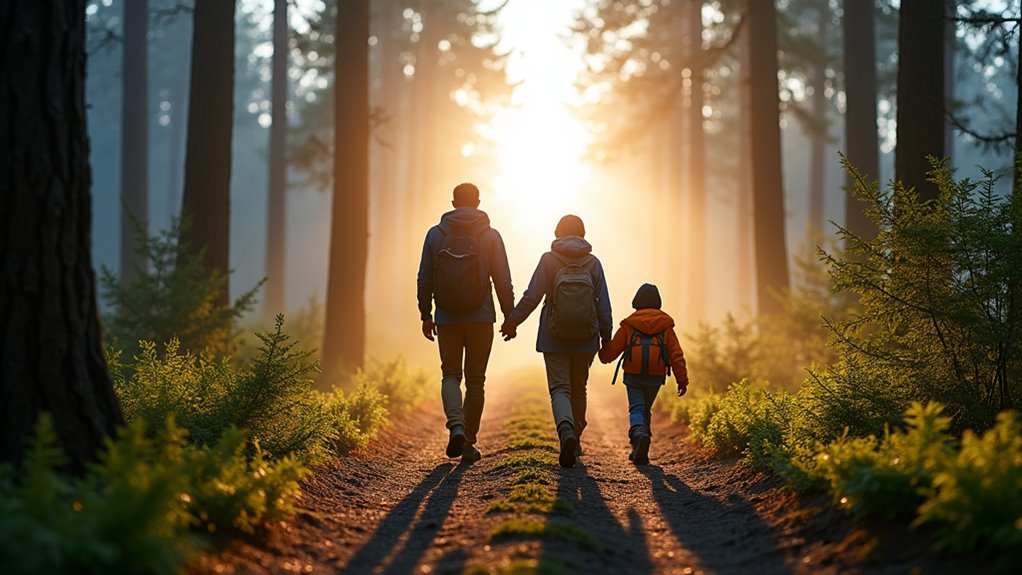
While most families sleep in on weekends, you’ll want to set those alarms early for your hiking adventure. Starting your hike between 7-8 AM gives you significant advantages when traveling with kids. You’ll beat the afternoon heat that can quickly drain young hikers’ energy and patience.
Early starts also mean fewer crowds on popular trails, giving your children more space to explore safely without dodging other hikers.
Early morning hiking benefits include:
Starting early also reduces encounters with biting insects, as many mosquitoes and ticks are less active during the cooler morning hours.
Although adults can typically manage hunger and thirst for several hours, children’s smaller bodies and higher energy expenditure mean they’ll need fuel far more frequently on the trail. Pack twice as many snacks as you think you’ll need – trail mix, granola bars, fruit pouches, and crackers work well. Don’t forget everyone’s favorites to boost morale when energy dips.
Water’s equally critical. Bring one liter per person for short hikes, more for longer adventures. Consider electrolyte tablets for hot weather or strenuous trails. Pack drinks in lightweight, spillproof containers that kids can handle independently.
Store snacks in easily accessible pockets so you’re not digging through your entire pack when someone gets hangry halfway up the mountain. For families considering more challenging adventures, the US offers incredible glacier climbing trails that require even more careful nutrition and hydration planning.
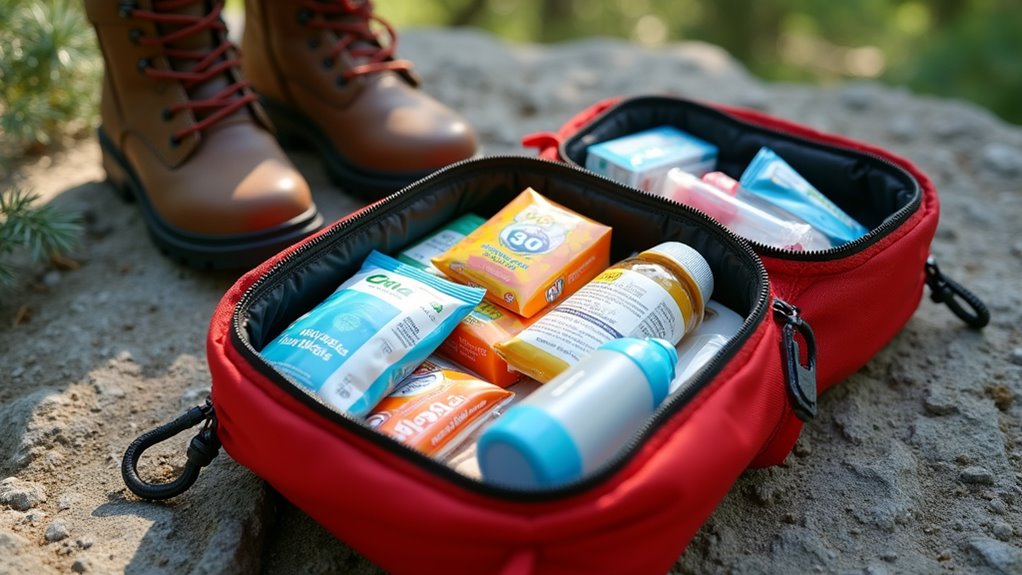
When you’re hiking with kids, minor injuries become major drama without the right supplies on hand. You’ll want to pack a thorough first aid kit that goes beyond basic bandages. Children are naturally curious and clumsy on trails, making scrapes, cuts, and bumps inevitable.
Essential items for your hiking first aid kit:
A comprehensive first aid kit turns trail mishaps with children from potential disasters into minor inconveniences you can handle confidently.
Don’t forget to include any specific medications your children take regularly. Check expiration dates before each trip and replace items as needed.
A well-prepared kit transforms potential emergencies into manageable moments. Consider packing essential first aid items specifically designed for outdoor adventures to ensure you’re ready for any situation the trail might present.
Giving children ownership over their hiking gear transforms reluctant walkers into enthusiastic adventurers. When kids select their own backpack, they’ll wear it proudly and take responsibility for carrying their belongings.
Let them choose colors, patterns, or designs that excite them – a dinosaur-themed pack or bright purple straps can make all the difference.
Size the backpack appropriately for their age and build. A 10-liter pack works well for younger children, while teens can handle 15-20 liters.
Include them in selecting other gear too: water bottles, hiking poles, or rain jackets. They’ll feel more invested in the trip when using equipment they’ve chosen.
Don’t forget to test everything at home first. Let them pack and wear their gear around the house to ensure comfort and proper fit.
Having the right backpack gear ensures your children are prepared for whatever adventures await on the trail.
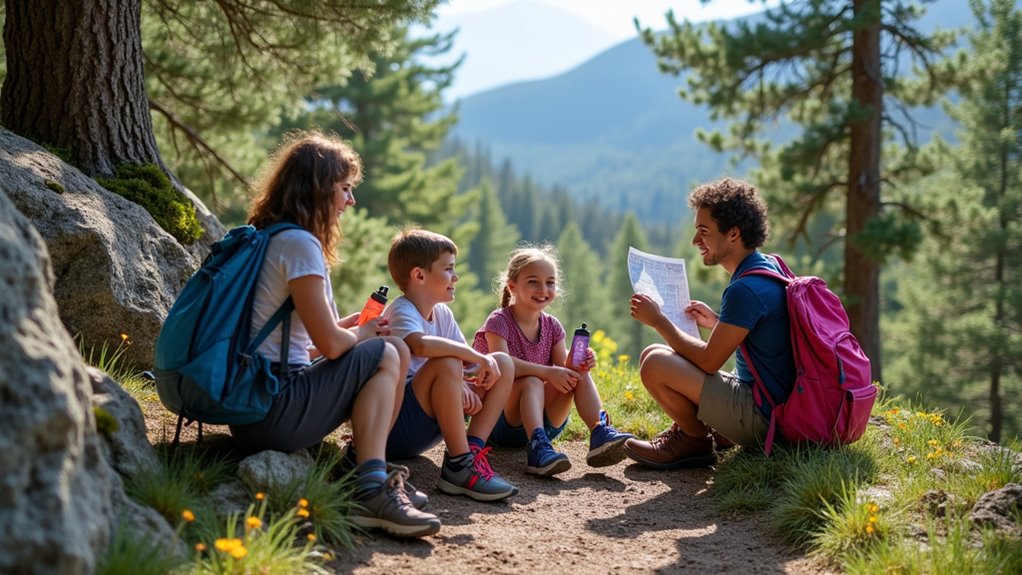
Since children’s legs are shorter and their energy levels fluctuate more dramatically than adults’, you’ll need to build frequent breaks into your hiking timeline. Plan stops every 15-20 minutes rather than pushing through like you might on solo hikes. These breaks aren’t just about rest—they’re opportunities for kids to explore and stay engaged.
Strategic break locations make all the difference:
Making these stops part of a kid-friendly adventure helps maintain their enthusiasm and prevents the common meltdowns that occur when children become overtired on the trail.
Give each child a small bag or container to collect their treasures.
Consider creating different difficulty levels based on ages – older kids can search for more specific items while younger ones focus on basic shapes and colors.
This approach keeps children engaged, encourages observation skills, and makes the entire hike feel like an exciting game rather than exercise.
Older kids often have longer attention spans and greater physical capabilities, making them perfect candidates for more challenging scavenger hunt objectives that can keep them motivated throughout longer hiking adventures.

Before stepping onto any trail, you’ll want to establish clear safety expectations with your kids to prevent accidents and build their confidence outdoors. Think of this as creating a foundation that’ll keep everyone safe while still allowing for adventure and exploration.
Cover these essential safety rules during your pre-hike discussion:
Practice these rules at home first, so they’ll become second nature on the trail. Just like when deciding whether to rent or buy equipment for outdoor activities, teaching safety fundamentals upfront saves time and prevents problems later.
While your kids might start the hike with boundless energy, they’ll inevitably need rest stops along the way – and that’s where smart entertainment choices can transform potential meltdowns into memorable moments.
Pack lightweight options that don’t require batteries or electronics. A magnifying glass lets kids examine rocks, leaves, and insects up close. Trail mix games work perfectly – have them sort nuts by type or count raisins. Bring a small notepad for nature sketching or simple word games like “I Spy.”
Consider compact activity books designed for outdoor adventures, featuring scavenger hunts or wildlife identification guides. Small toys like travel-sized coloring books with a few crayons can occupy restless hands.
For unpredictable weather during trail breaks, having a lightweight smock can keep kids comfortable while they enjoy their entertainment activities.

Mountain weather can shift from sunny to stormy in minutes, making layered clothing your best defense against uncomfortable – or even dangerous – conditions. You’ll want to dress your kids in moisture-wicking base layers, insulating middle layers, and waterproof outer shells that can be easily added or removed as temperatures fluctuate.
Mountain weather changes fast, so layered clothing protects kids from uncomfortable and potentially dangerous temperature swings.
Pack these essential layers for each child:
This system keeps kids comfortable while preventing hypothermia or overheating during your adventure.
Beyond keeping your children warm and dry, you’ll need to maintain their safety on the trail through smart grouping strategies. The buddy system works particularly well for children ages 8 and older who’ve developed better judgment and communication skills.
Pair kids of similar hiking abilities together, ensuring each buddy knows their partner’s full name and any medical conditions. Establish clear boundaries—buddies must stay within sight of each other and within earshot of adults. Teach them to stop immediately if they become separated and call out loudly.
Give each pair a whistle for emergencies and assign them specific check-in points along the trail. This system builds responsibility while providing an extra safety layer that doesn’t rely solely on adult supervision. Consider your family’s overall camping style when determining how structured or flexible to make these buddy system rules.
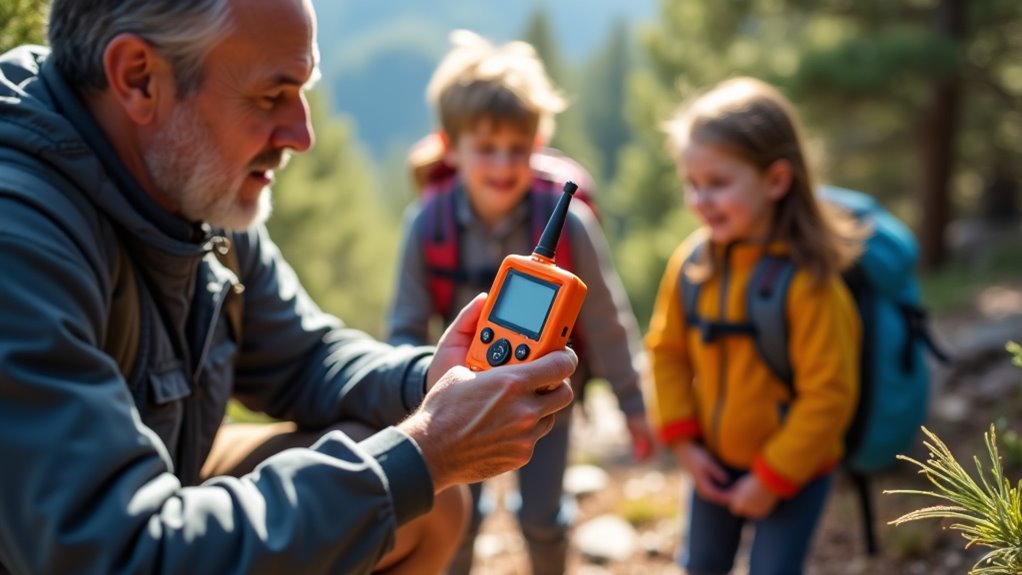
Even when you’ve planned meticulously and implemented smart safety strategies, unexpected situations can arise on remote trails where cell service doesn’t exist. Emergency communication devices become your lifeline when children get injured, weather turns dangerous, or you become lost. These tools connect you to rescue services even in the most isolated wilderness areas.
Consider carrying these emergency communication options:
Test all devices before departing and guarantee batteries are fully charged. Many camping couples also find these communication devices valuable for coordinating meetups when exploring different trail sections separately.
When hiking with children, you’ll discover that their natural pace differs markedly from adult expectations, and forcing them to match your speed creates frustration for everyone involved.
Plan for frequent stops every 15-20 minutes, allowing kids to rest, explore interesting rocks, or examine bugs along the trail.
Calculate distances using the rule of thumb: children can typically handle one mile per year of age, plus one additional mile. A six-year-old might manage two to three miles comfortably.
Factor in elevation gain, which considerably impacts difficulty.
Choose loop trails or out-and-back routes with clear turnaround points.
Remember that children often surge ahead initially, then tire quickly.
Build buffer time into your schedule and celebrate small milestones to maintain their enthusiasm throughout the journey.
For families who enjoy camping and hiking, consider how eco-friendly practices can enhance your outdoor adventures while teaching children to respect and protect the natural environments they explore.
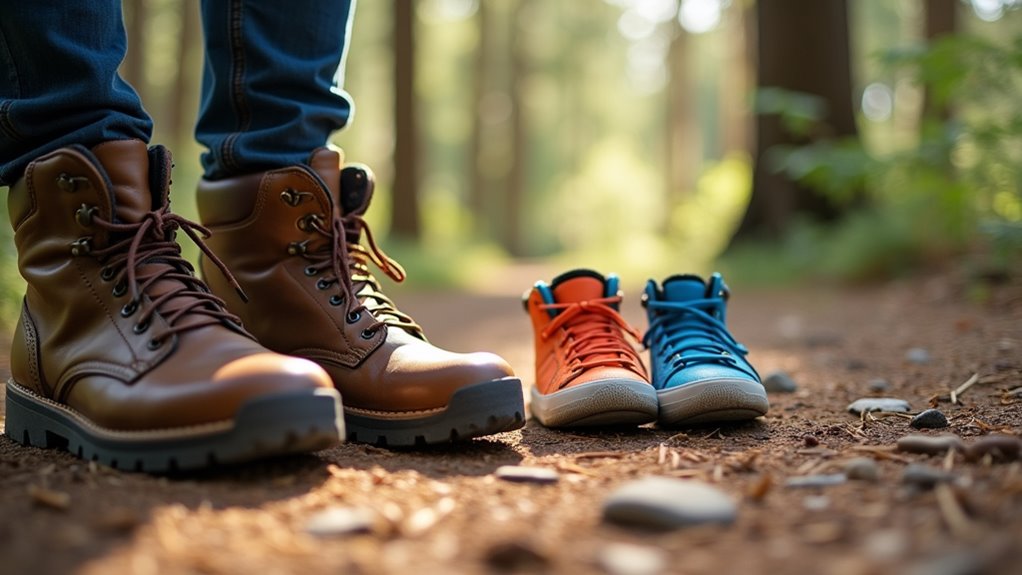
Proper footwear can make or break your child’s hiking experience, as uncomfortable shoes quickly transform an exciting adventure into a miserable ordeal filled with complaints and potential injuries.
You’ll want to guarantee your children wear hiking shoes they’ve already broken in at home. New shoes create blisters and hot spots that’ll have them limping within the first mile. Test their footwear during neighborhood walks or playground visits before hitting the trails.
Consider these essential features for children’s hiking shoes:
Just as you’d carefully research the perfect camping location for your family’s overnight adventures, investing time in selecting proper hiking footwear ensures your day trips start on the right foot.
Since children burn through energy faster than adults on the trail, you’ll need to pack snacks that deliver quick fuel and keep their spirits high throughout the hike.
Choose portable options like trail mix with nuts and dried fruit, granola bars, or homemade energy balls. Fresh fruit such as apples, bananas, or grapes provides natural sugars and hydration.
Pack familiar favorites your kids already enjoy—this isn’t the time to introduce new foods. Avoid anything that melts easily or requires utensils.
Crackers with peanut butter packets offer protein and carbs, while string cheese provides calcium.
Divide snacks into individual portions using small containers or bags, making distribution quick and mess-free.
Plan for frequent snack breaks to maintain energy levels. Just like preparing for potential road trip breakdowns, having backup snacks stored in different locations ensures you’re never caught without fuel when little hikers hit an energy wall.
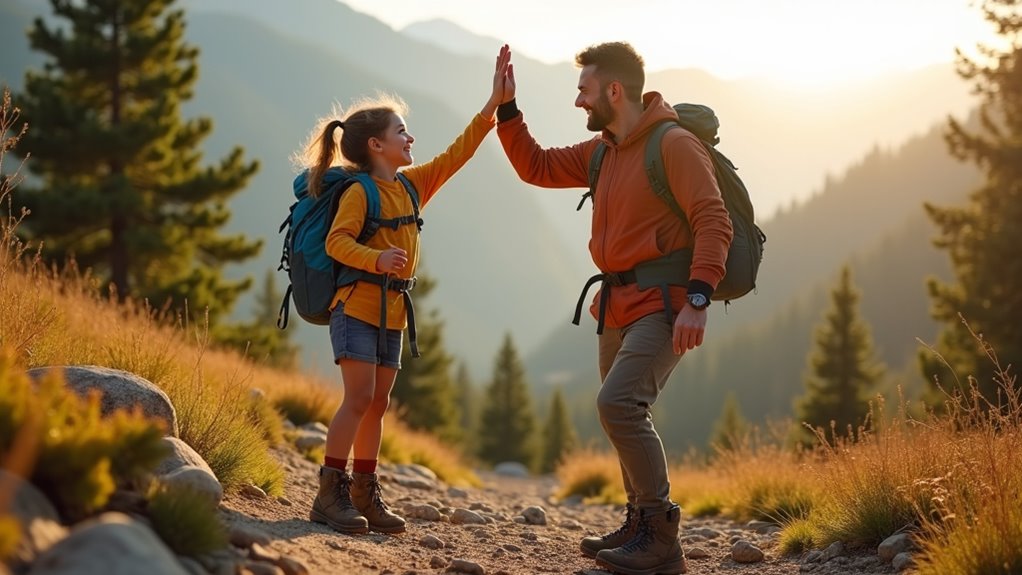
Maintaining your children’s motivation on the trail requires strategic praise and celebration of their achievements, no matter how small they might seem. You’ll find that acknowledging every milestone keeps their spirits high and legs moving forward.
Focus on effort rather than speed or distance. When your child climbs over a fallen log or spots wildlife, celebrate these moments enthusiastically. Create mini-goals throughout the hike, like reaching the next bend or rock formation, then reward their progress with high-fives or stickers.
These same encouragement techniques work wonderfully for camping adventures, where positive reinforcement helps children embrace new outdoor experiences and build confidence in nature.
Before you hit the trail, establish clear turnaround points that match your children’s physical capabilities rather than sticking rigidly to your original destination. Mark realistic checkpoints at the halfway point, two-thirds distance, and other logical spots where you can assess everyone’s energy levels.
Watch for signs like increased complaining, slower pace, or requests for frequent breaks. Don’t view turning back as failure—it’s smart planning that ensures everyone enjoys the experience.
Consider your youngest hiker’s abilities when setting these markers, and communicate the plan beforehand so kids understand they’re not being punished if you reverse course. Flexible turnaround points prevent exhaustion, meltdowns, and negative associations with hiking that could discourage future adventures.
If you’re planning a multi-day outdoor adventure, research kid-friendly camping spots that offer easy trail access and family amenities to extend your hiking experience.
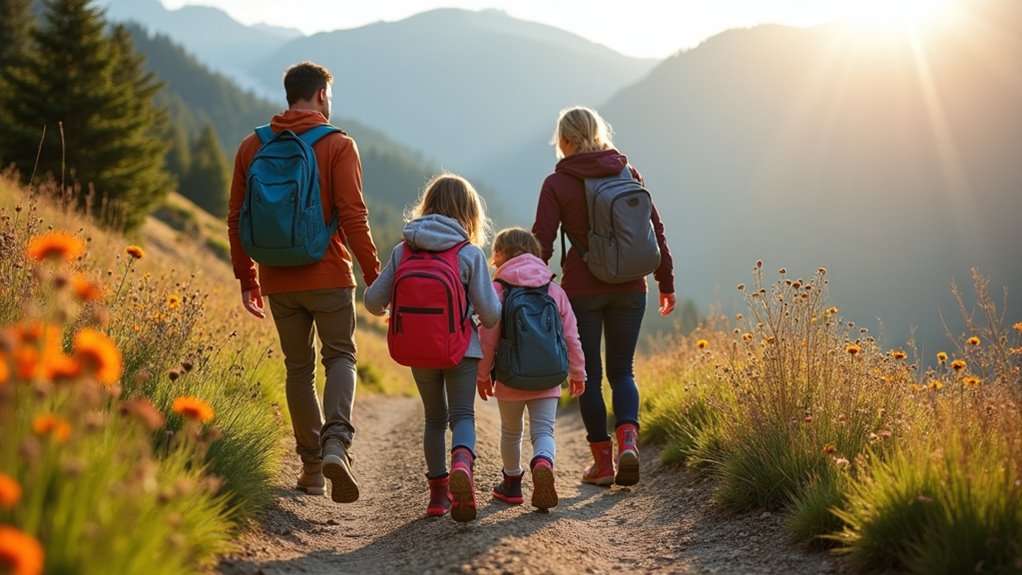
Teaching your children Leave No Trace principles while hiking creates lifelong environmental stewards and guarantees these beautiful trails remain pristine for future generations. Make it a fun learning experience by turning conservation into games and hands-on activities. Kids naturally absorb these lessons when they’re actively involved.
Children become passionate environmental protectors when Leave No Trace principles are taught through engaging outdoor games and hands-on trail adventures.
Turn your hike into an environmental adventure:
You’ll be amazed how quickly children embrace these principles when presented as exciting outdoor challenges. Following proper camping etiquette not only protects the environment but also ensures a respectful outdoor experience for all families sharing these natural spaces.
While your kids are busy practicing their newfound conservation skills, don’t forget that extended time outdoors exposes them to sun and insects that can quickly turn a fun adventure into an uncomfortable experience.
Pack broad-spectrum sunscreen with SPF 30 or higher and reapply every two hours, especially after sweating. Don’t overlook often-missed spots like ears, neck, and tops of feet.
Bring wide-brimmed hats and lightweight long-sleeved shirts for extra protection during peak sun hours.
Choose DEET-based insect repellent for effective tick and mosquito protection, applying it after sunscreen.
For younger children, consider picaridin-based alternatives that are gentler on sensitive skin. Pack a small bottle for reapplication during longer hikes, and teach kids to avoid touching their faces after application.
These protection strategies become even more important during winter camping when harsh conditions can quickly expose unprotected skin to frostbite and increased UV reflection from snow.
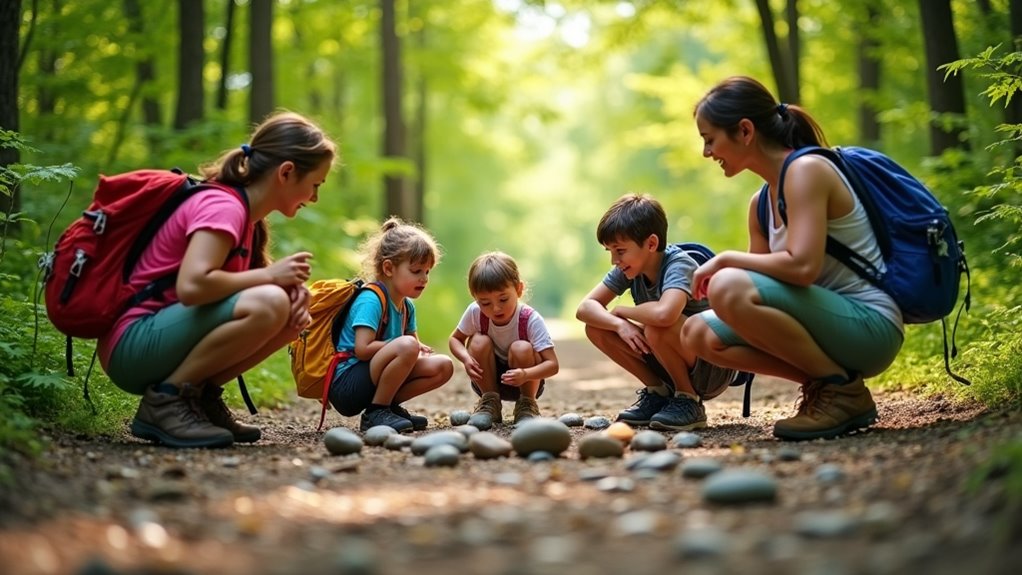
Since children’s energy naturally ebbs and flows during outdoor adventures, you’ll want to transform necessary rest breaks into engaging mini-adventures that keep spirits high. Pack lightweight entertainment that doubles as education. Simple games create memorable moments while giving tired legs time to recover.
Transform unavoidable rest stops into exciting discovery moments that recharge young adventurers and turn complaints into enthusiasm for the trail ahead.
Turn each stop into discovery time with these engaging activities:
These activities refresh both body and mind, making children enthusiastic to continue exploring rather than complaining about tired feet. Many of these same camping activities work perfectly for toddlers and can be adapted for various ages and hiking environments.
Weather conditions can shift rapidly in outdoor environments, turning a pleasant family hike into a challenging ordeal if you’re unprepared. Always check the forecast before heading out, but don’t rely on it completely. Pack rain gear for everyone, including waterproof jackets and extra clothing layers.
Identify shelter options along your route—covered pavilions, visitor centers, or sturdy trees can provide temporary refuge.
Create an alternative indoor plan that’ll excite your kids if weather forces you to abandon the hike entirely. Consider visiting nearby museums, indoor climbing walls, or family-friendly restaurants. You’ll avoid disappointed children and maintain the adventure spirit.
Keep emergency supplies in your vehicle, including blankets, snacks, and first aid materials. Weather preparedness transforms potential disasters into manageable situations. Remember that proper camping preparation principles apply to day hiking as well, ensuring your family stays safe and comfortable regardless of changing conditions.

Beyond preparing for unpredictable conditions, you’ll want to capture the memories your family creates on the trail. These moments become treasured keepsakes that your children will cherish for years.
Bring a lightweight camera or use your smartphone to document the journey. Encourage kids to take their own photos from their unique perspective. Consider packing a small journal where each family member can write about their favorite discoveries or funny moments from the hike.
Many of these camping tips for beginners also apply to day hiking adventures with families, helping you create a more organized and enjoyable outdoor experience.
You’ve got the roadmap for hiking success with your kids. Like planting seeds in a garden, each preparation step you take now will bloom into precious memories on the trail. Don’t overthink it—start with short, familiar routes and build confidence together. Your children will surprise you with their resilience and wonder. Pack your patience along with those extra snacks, embrace the slower pace, and watch as nature becomes their greatest classroom and playground.